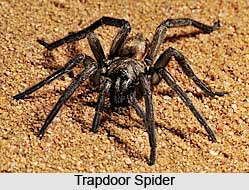 Trapdoor Spider is the name given to several underground spiders of strictly nocturnal habits found under stones and hollows of trees. They fall under a special group called Mygalomorphs characterized by the formidable jaws directed forwards and the fangs, striking downwards like a pickaxe. Many of them build silk tubes, the mouths of which are in some cases closed by trapdoors. There are several of them in India - they are of fairly large size, dark brown or sepia tinted, with stout hairy legs.
Trapdoor Spider is the name given to several underground spiders of strictly nocturnal habits found under stones and hollows of trees. They fall under a special group called Mygalomorphs characterized by the formidable jaws directed forwards and the fangs, striking downwards like a pickaxe. Many of them build silk tubes, the mouths of which are in some cases closed by trapdoors. There are several of them in India - they are of fairly large size, dark brown or sepia tinted, with stout hairy legs.
Trapdoor Spider is a very common name given to a number of hairy, large and harmless tropical spiders which live in underground nests. These spiders form very long burrows in the earth and line those burrows with silk which they spin by themselves, and fashion the point of entrance a hinged, bevel-edged, exactly fitting trapdoor usually constructed by alternate layers of silk and earth. The door`s upper surface may be blanketed with gravel or earth and in this way the entrance is disguised.
The trapdoor is not easy to see when the same has been closed by the spider since the soil and plant materials properly camouflage it. On one side, the trapdoor is hinged with silk. The trapdoor spiders are mostly nocturnal, and they thus wait for their prey while they keep on holding the underside of their door with the help of their claws on their tarsi. The prey of the trapdoor spiders is caught when arthropods, insects or small vertebrates upset the `trip` lines which the trapdoor spider lays out all round its trapdoor, thus giving an alert to the spider about a perspective meal. Then, the trapdoor spider detects the prey by sensing its vibrations and, when the spider gets close to it, jumps out of the underground shelter to capture the prey.
A hungry trapdoor spider will wait half a distance out of its underground shelter for a meal. The male trapdoor spiders are able to overcome the aggressive reactions of the female, but the same is not known how. The female trapdoor spiders never move a long distance from their burrows, mainly if they possess an egg sac. At this period, the female captures food and regurgitate it in order to feed her spider lings. There are various enemies of trapdoor spiders which include certain pompilids (spider wasps), and they find out the underground shelters of trapdoor spiders and are successful to enter inside it. Then they sting the trapdoor spider and lay their eggs (normally one per spider) on the spider`s body. When the eggs of these wasps hatch, the larva consumes the spider alive.
The one somewhat dangerous local species, Poecilotheria sp., is a mygalomorph spider. It is a large blackish, hairy spider common in the hollows of jungle trees in South India. In the state of Kerala it is called Oorambuli (Giant Hairy Spider), and in Tamil Nadu the Catleg Spider.






































